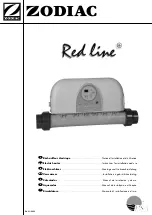
Connection to the Vehicle's Cooling System
DBW 160/230/300/350
66
6
Connection to the Vehicle's Cooling System
The heater is to be connected to the vehicle's cooling system in
accordance with Figs. 3, 4, 7, 10, 13 and 17. A minimum of 10 litres of
coolant must be maintained in the cooling system.
As a rule, the water hoses supplied by SPHEROS with the heater should
be used. If this is not the case, the hoses must comply with DIN 73411
requirements as a minimum. The hoses are to be routed without any
kinks and - for proper venting of the heater - in an upward pitch, if pos-
sible. Hose connections must be secured against slipping off by means
of hose clamps.
NOTE:
Consider proper torque values when using hose clamps.
In the vehicle cooling system, or in a separate heating circuit, only pres-
sure control valves with an opening pressure of min. 0.4 bar and max.
2.0 bar may be used.
Before the heater is started up for the first time, or after the coolant has
been replaced, it must be ensured that the cooling system is properly
bled. Heater and piping should be installed in such a way that static
bleeding of the system is ensured.
Perfect ventilation can be identified by the circulating pump operating
almost silently. Poor bleeding may cause to trip the resettable tem-
perature limiter or the overheat fuse while the heater is operating.
When using circulating pump U 4855 / Aquavent 6000C, the circulating
pump will be automatically deactivated approx. 15 seconds after its ac-
tivation if coolant is lacking or a blockage of the pump impeller has oc-
curred, and can then be restarted after approx. 2 minutes.
In the case of circulating pump U 4856 / Aquavent 6000SC the circulat-
ing pump will be automatically deactivated approx. 45 seconds after its
activation if coolant is lacking or a blockage of the pump impeller has oc-
curred, and can then be restarted after approx. 2 minutes.
















































